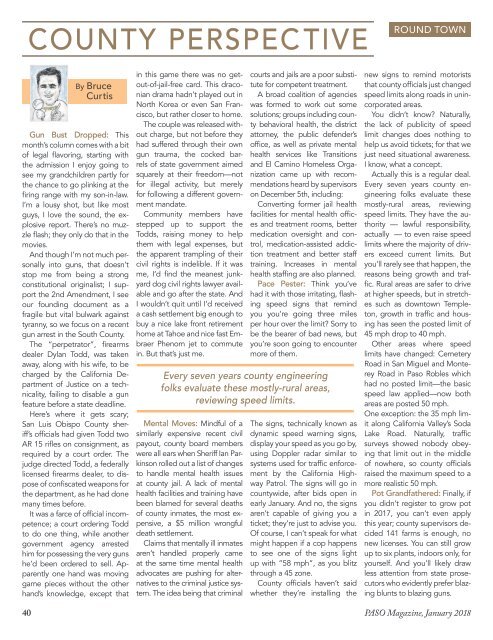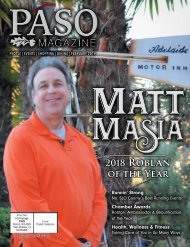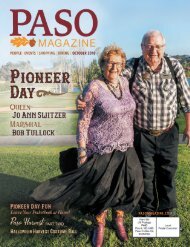2018 January PASO Magazine #201
PASO Magazine - The Story of Us.
PASO Magazine - The Story of Us.
You also want an ePaper? Increase the reach of your titles
YUMPU automatically turns print PDFs into web optimized ePapers that Google loves.
COUNTY PERSPECTIVE<br />
ROUND TOWN<br />
By Bruce<br />
Curtis<br />
Gun Bust Dropped: This<br />
month’s column comes with a bit<br />
of legal flavoring, starting with<br />
the admission I enjoy going to<br />
see my grandchildren partly for<br />
the chance to go plinking at the<br />
firing range with my son-in-law.<br />
I’m a lousy shot, but like most<br />
guys, I love the sound, the explosive<br />
report. There’s no muzzle<br />
flash; they only do that in the<br />
movies.<br />
And though I’m not much personally<br />
into guns, that doesn’t<br />
stop me from being a strong<br />
constitutional originalist; I support<br />
the 2nd Amendment, I see<br />
our founding document as a<br />
fragile but vital bulwark against<br />
tyranny, so we focus on a recent<br />
gun arrest in the South County.<br />
The “perpetrator”, firearms<br />
dealer Dylan Todd, was taken<br />
away, along with his wife, to be<br />
charged by the California Department<br />
of Justice on a technicality,<br />
failing to disable a gun<br />
feature before a state deadline.<br />
Here’s where it gets scary;<br />
San Luis Obispo County sheriff’s<br />
officials had given Todd two<br />
AR 15 rifles on consignment, as<br />
required by a court order. The<br />
judge directed Todd, a federally<br />
licensed firearms dealer, to dispose<br />
of confiscated weapons for<br />
the department, as he had done<br />
many times before.<br />
It was a farce of official incompetence;<br />
a court ordering Todd<br />
to do one thing, while another<br />
government agency arrested<br />
him for possessing the very guns<br />
he’d been ordered to sell. Apparently<br />
one hand was moving<br />
game pieces without the other<br />
hand’s knowledge, except that<br />
in this game there was no getout-of-jail-free<br />
card. This draconian<br />
drama hadn’t played out in<br />
North Korea or even San Francisco,<br />
but rather closer to home.<br />
The couple was released without<br />
charge, but not before they<br />
had suffered through their own<br />
gun trauma, the cocked barrels<br />
of state government aimed<br />
squarely at their freedom—not<br />
for illegal activity, but merely<br />
for following a different government<br />
mandate.<br />
Community members have<br />
stepped up to support the<br />
Todds, raising money to help<br />
them with legal expenses, but<br />
the apparent trampling of their<br />
civil rights is indelible. If it was<br />
me, I‘d find the meanest junkyard<br />
dog civil rights lawyer available<br />
and go after the state. And<br />
I wouldn’t quit until I’d received<br />
a cash settlement big enough to<br />
buy a nice lake front retirement<br />
home at Tahoe and nice fast Embraer<br />
Phenom jet to commute<br />
in. But that’s just me.<br />
Mental Moves: Mindful of a<br />
similarly expensive recent civil<br />
payout, county board members<br />
were all ears when Sheriff Ian Parkinson<br />
rolled out a list of changes<br />
to handle mental health issues<br />
at county jail. A lack of mental<br />
health facilities and training have<br />
been blamed for several deaths<br />
of county inmates, the most expensive,<br />
a $5 million wrongful<br />
death settlement.<br />
Claims that mentally ill inmates<br />
aren’t handled properly came<br />
at the same time mental health<br />
advocates are pushing for alternatives<br />
to the criminal justice system.<br />
The idea being that criminal<br />
courts and jails are a poor substitute<br />
for competent treatment.<br />
A broad coalition of agencies<br />
was formed to work out some<br />
solutions; groups including county<br />
behavioral health, the district<br />
attorney, the public defender’s<br />
office, as well as private mental<br />
health services like Transitions<br />
and El Camino Homeless Organization<br />
came up with recommendations<br />
heard by supervisors<br />
on December 5th, including:<br />
Converting former jail health<br />
facilities for mental health offices<br />
and treatment rooms, better<br />
medication oversight and control,<br />
medication-assisted addiction<br />
treatment and better staff<br />
training. Increases in mental<br />
health staffing are also planned.<br />
Pace Pester: Think you’ve<br />
had it with those irritating, flashing<br />
speed signs that remind<br />
you you’re going three miles<br />
per hour over the limit? Sorry to<br />
be the bearer of bad news, but<br />
you’re soon going to encounter<br />
more of them.<br />
Every seven years county engineering<br />
folks evaluate these mostly-rural areas,<br />
reviewing speed limits.<br />
The signs, technically known as<br />
dynamic speed warning signs,<br />
display your speed as you go by,<br />
using Doppler radar similar to<br />
systems used for traffic enforcement<br />
by the California Highway<br />
Patrol. The signs will go in<br />
countywide, after bids open in<br />
early <strong>January</strong>. And no, the signs<br />
aren’t capable of giving you a<br />
ticket; they’re just to advise you.<br />
Of course, I can’t speak for what<br />
might happen if a cop happens<br />
to see one of the signs light<br />
up with “58 mph”, as you blitz<br />
through a 45 zone.<br />
County officials haven’t said<br />
whether they’re installing the<br />
new signs to remind motorists<br />
that county officials just changed<br />
speed limits along roads in unincorporated<br />
areas.<br />
You didn’t know? Naturally,<br />
the lack of publicity of speed<br />
limit changes does nothing to<br />
help us avoid tickets; for that we<br />
just need situational awareness.<br />
I know, what a concept.<br />
Actually this is a regular deal.<br />
Every seven years county engineering<br />
folks evaluate these<br />
mostly-rural areas, reviewing<br />
speed limits. They have the authority<br />
— lawful responsibility,<br />
actually — to even raise speed<br />
limits where the majority of drivers<br />
exceed current limits. But<br />
you’ll rarely see that happen, the<br />
reasons being growth and traffic.<br />
Rural areas are safer to drive<br />
at higher speeds, but in stretches<br />
such as downtown Templeton,<br />
growth in traffic and housing<br />
has seen the posted limit of<br />
45 mph drop to 40 mph.<br />
Other areas where speed<br />
limits have changed: Cemetery<br />
Road in San Miguel and Monterey<br />
Road in Paso Robles which<br />
had no posted limit—the basic<br />
speed law applied—now both<br />
areas are posted 50 mph.<br />
One exception: the 35 mph limit<br />
along California Valley’s Soda<br />
Lake Road. Naturally, traffic<br />
surveys showed nobody obeying<br />
that limit out in the middle<br />
of nowhere, so county officials<br />
raised the maximum speed to a<br />
more realistic 50 mph.<br />
Pot Grandfathered: Finally, if<br />
you didn’t register to grow pot<br />
in 2017, you can’t even apply<br />
this year; county supervisors decided<br />
141 farms is enough, no<br />
new licenses. You can still grow<br />
up to six plants, indoors only, for<br />
yourself. And you’ll likely draw<br />
less attention from state prosecutors<br />
who evidently prefer blazing<br />
blunts to blazing guns.<br />
40 <strong>PASO</strong> <strong>Magazine</strong>, <strong>January</strong> <strong>2018</strong>


















